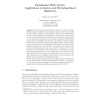107
click to vote
CTRSA
2007
Springer
15 years 6 months ago
2007
Springer
In 1999, two signature schemes based on the flexible RSA problem (a.k.a. strong RSA problem) were independently introduced: the Gennaro-Halevi-Rabin (GHR) signature scheme and the...
104
Voted
CCS
2007
ACM
15 years 6 months ago
2007
ACM
We construct two new multiparty digital signature schemes that allow multiple signers to sequentially produce a compact, fixed-length signature. First, we introduce a new primiti...
107
click to vote
ACNS
2007
Springer
15 years 6 months ago
2007
Springer
Recently, there are several generic transformation techniques proposed for converting unforgeable signature schemes (the message in the forgery has not been signed yet) into strong...
91
Voted
ICC
2007
IEEE
15 years 6 months ago
2007
IEEE
Abstract— An important issue in mobile commerce (mcommerce) is to exchange digital data between two distributed parties in an efficient and fair manner. In this paper, a lightwe...
CISIM
2007
IEEE
15 years 6 months ago
2007
IEEE
The standard digital signature scheme can be easily subject to key exposure problem In order to overcome this problem; a feasible and effective approach is employed by key-evolving...
AFRICACRYPT
2008
Springer
15 years 6 months ago
2008
Springer
In this paper, we investigate the security of the Tractable Rationale Maps Signature (TRMS) signature scheme [9] proposed at PKC’05. To do so, we present a hybrid approach for so...
105
click to vote
PROVSEC
2009
Springer
15 years 6 months ago
2009
Springer
Abstract. We revisit the notion of the anonymous signature, first formalized by Yang, Wong, Deng and Wang [12], and then further developed by Fischlin [6] and Zhang and Imai [13]. ...
114
Voted
ASIACRYPT
2009
Springer
15 years 7 months ago
2009
Springer
A leakage-resilient cryptosystem remains secure even if arbitrary, but bounded, information about the secret key (or possibly other internal state information) is leaked to an adv...
109
click to vote
ASIACRYPT
2009
Springer
15 years 7 months ago
2009
Springer
We demonstrate how the framework that is used for creating efficient number-theoretic ID and signature schemes can be transferred into the setting of lattices. This results in cons...
DCC
2005
IEEE
15 years 12 months ago
2005
IEEE
Signcryption [35] is a public key primitive that achieves the functionality of both an encryption scheme and a signature scheme simultaneously. It does this more efficiently than a...




